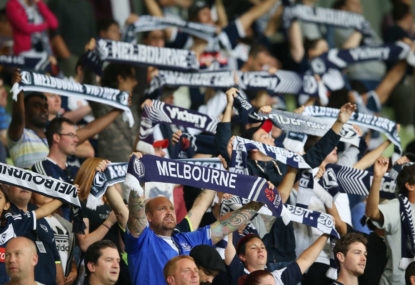The Melbourne Rectangular Stadium (MRS) was built to host sports that require rectangular playing areas: football, rugby union and rugby league.
In 2006, the Victorian Government announced it would build a new state-of-the-art rectangular stadium with a capacity of 20,000, within Melbourne’s Olympic Park District.
However, for the stadium to be viable, the Victorian Government needed Melbourne’s only A-League club at that time, Melbourne Victory Football Club (Melbourne Victory) to sign as a tenant.
Melbourne Victory refused to be involved with the new stadium unless its capacity was significantly increased and, as a result, the Victorian Government increased the proposed stadium’s capacity to 30,050 seats.
Construction of AAMI Park was completed in 2010 with the total cost reportedly $267.5 million.
The AAMI Insurance company bought the naming rights for the stadium and it is now often referred to as AAMI Park.
Since its opening, AAMI Park has consistently been a winner – both on and off the park. A-League players consistently rate the playing surface as the best or second best in the competition and for A-League fans. AAMI Park is, by far, the best venue to watch football in Victoria.
However, the 30k capacity of AAMI Park prevents the venue from hosting significant sporting events. Even though the stadium’s foundations were specifically designed to allow new stands to be built to increase capacity, the stadium’s roof design will add significant additional costs to expansion.
Additionally, current attendances for sport in Melbourne suggest it would be difficult to create a positive business case for a rectangular stadium with 50k capacity in Melbourne.
It’s likely such a stadium would be filled just four to six times per year. The rest of the time, it would be filled to 60-70 per cent capacity for Melbourne Victory home games and 20-30 per cent capacity when Melbourne City, Melbourne Storm and Melbourne Rebels play there.
So expanding AAMI Park, or building a new 50k capacity stadium, is not justified.
There is, however, a way to increase the capacity of existing stadiums relatively cheaply, while maintain a lower capacity for teams that can’t draw big crowds. To do this requires converting existing seats to ‘Rail Seating’, sometimes referred to as ‘Safe Standing’.
Rail Seating is presently being deployed in sections of major football stadiums across Europe, including the stadiums of Bayer Leverkusen, Borussia Dortmund, VfB Stuttgart, Werder Bremen and VfL Wolfsburg in Germany, RSC Anderlecht in Belgium, PSV Eindhoven in Holland and Celtic in Scotland.
AAMI Park currently has 30,050 seats with approximate allocations:
A) North andamp; South goal: 11.6k
B) Level 3 (East andamp; West): 10k
C) Level 1 (East andamp; West): 6.9k
D) Dining/Corporate Boxes: 1.6k
I don’t propose converting all AAMI Park’s seats to rail sating – just converting the seats in the areas behind each goal, and on Level 3. So a total, 21.6k seats would be converted from traditional seating to Rail Seating.
Once the Rail Seats are installed, those areas can be configured to allow Safe Standing.
In Germany, authorities allow two people to stand in spots allocated to one Rail Seat. In other countries they allow 1.5-1.8 people to stand per seat.
If Australia adopted the German standard, the conversions I recommended will increase the capacity of AAMI Park to 50,000 (8.5k traditional seats, 41.5k standing)
From what is reported the cost of such conversion will be less than $10 million (the cost varies depending on the existing infrastructure). This is obviously much cheaper than undertaking major construction to expand AAMI Park with new stands, or build a new stadium.
Besides the cheaper cost, rail seating provides capacity flexibility.
When Melbourne City, Melbourne Storm or Melbourne Rebels play home games, the stadium would be configured to 30k all-seating capacity.
When Melbourne Victory is playing, the club has the flexibility to configure the back rows on Level 3 for safe Standing and sell the front rows on Level 3 at premium reserved seat prices.
Safe standing will not only allow clubs to increase revenue from ticket sales and catering, but will significantly increase the vibrant atmosphere at A-League matches.






























































































